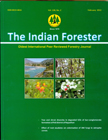Tree and Shrub Diversity in Degraded Hills of Bar-conglomerate Formation of Pali District of Rajasthan
DOI:
https://doi.org/10.36808/if/2012/v138i2/4593Keywords:
Degraded Hills, Vegetation Diversity, Importance Value Index, Vegetation StatusAbstract
Study on vegetation diversity in degraded hills of Bar conglomerate formation in Pali district of Rajasthan reveals the occurrence of 10 trees, 7 shrubs and 4 undershrubs/herbs with an average population of 16.9 tree, 116.8 shrubs and 4.8 herbs per plot. P. juliflora showed the highest population followed by Z. mauritiana. Frequency of occurrence, density and abundance were also highest for the P. juliflora. Species richness was the highest for tree and lowest for the shrubs, but Shanon-Weiner index was highest for shrubs. Population of shrubs was relatively more even as compared to the tree or undershrub/herb species. Importance value index was highest for P. juliflora among tree and Euphorbia caducifolia among the shrubs indicating a change of forest types from Tropical Euphorbia Scrub to Tropical Prosopis juliflora scrub.Downloads
Download data is not yet available.
Downloads
Published
2012-02-01
How to Cite
Kumar, A., Tripathi, B., & Singh, G. (2012). Tree and Shrub Diversity in Degraded Hills of Bar-conglomerate Formation of Pali District of Rajasthan. Indian Forester, 138(2), 107–112. https://doi.org/10.36808/if/2012/v138i2/4593
Issue
Section
Articles
License
Unless otherwise stated, copyright or similar rights in all materials presented on the site, including graphical images, are owned by Indian Forester.





